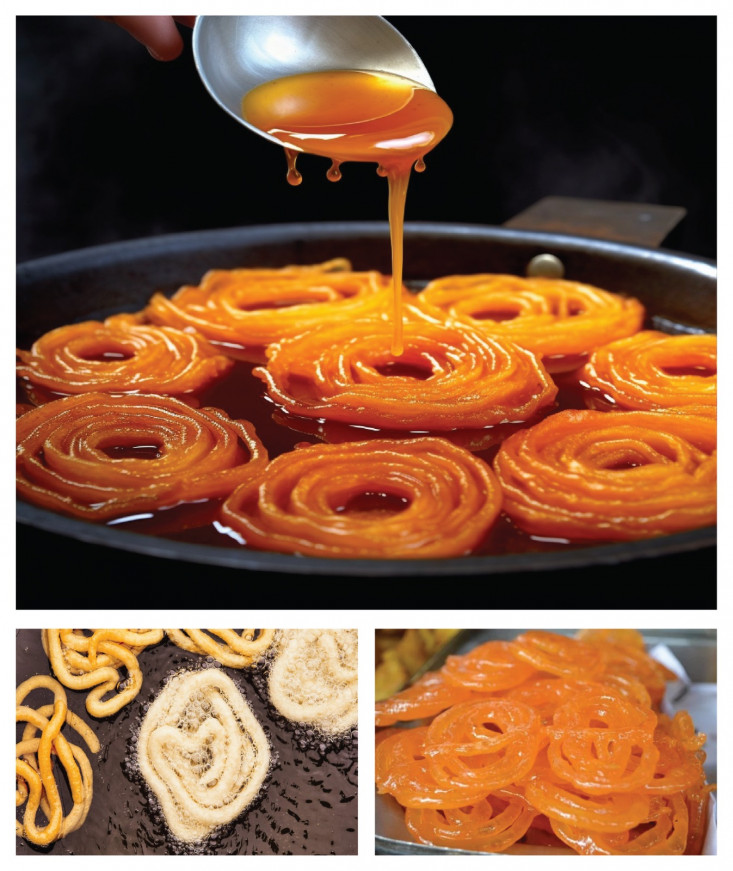
Jalebi Delights is the Sweet Journey of Irresistible and Flavorful Bliss.
Jalebi, a confectionary masterpiece, is not just a sweet treat but a cultural phenomenon that transcends borders and tantalizes taste buds across South Asia and the Middle East. This spiral-shaped dessert, soaked in sugary syrup, has a history as rich and intricate as its flavor profile. Let's explore the fascinating journey of Jalebi, from its origins to its enduring popularity today.
Origins and Historical Significance:
Jalebi's roots can be traced back to ancient India, with mentions in early Sanskrit literature. Its Arabic counterpart, known as Zalabia, also holds historical significance. Over the centuries, the sweet treat has evolved, adapting to regional tastes while preserving its essence.
Crafting the Perfect Jalebi:
Creating the perfect Jalebi requires skill and precision. The batter, typically made from fermented wheat flour or chickpea flour, is piped into hot oil in intricate spiral shapes. The frying process imparts the golden hue and crispy texture, transforming it into a delectable delight. The final touch involves soaking the fried spirals in sugar syrup, creating the characteristic sweetness.
Regional Variations:
Jalebi undergoes delightful transformations as it traverses different regions. In India, it is known by various names like Jilapi, Jaleba, or Imarti, each with its unique preparation method. The Middle East boasts its own versions, with variations in shape, size, and syrup thickness.
Festivals and Celebrations:
Jalebi is synonymous with celebrations in South Asia. It graces the festive table during occasions like Diwali, Eid, Holi, and weddings. Its presence symbolizes joy, prosperity, and the sweetness of life, making it an integral part of cultural festivities.
Street Food Sensation:
Jalebi's allure extends to bustling street corners, where skilled vendors craft the sweet spirals right before the eyes of eager customers. The aroma of frying Jalebi wafts through the air, inviting passersby to indulge in this irresistible street food delight.
Global Recognition:
Beyond its South Asian and Middle Eastern origins, Jalebi has gained international acclaim. Its unique texture and sweet syrupy goodness have found admirers worldwide, making it a popular dessert in diverse culinary landscapes.
Culinary Versatility:
While traditionally enjoyed on its own, Jalebi has also found its way into innovative culinary creations. It serves as an accompaniment to other desserts, complements ice creams, and even makes appearances in fusion dishes, showcasing its adaptability.
Symbolism in Art and Literature:
Jalebi's cultural significance extends beyond the culinary realm. It has inspired artists and writers, finding mentions in poems, songs, and paintings. The intricate spiral shape is often seen as a metaphor for life's cyclical nature.
Health Considerations:
While undeniably delicious, the sweetness of Jalebi comes with a caveat. Its high sugar content and deep-frying process contribute to its calorific profile. Moderation is key, as with any indulgent treat, to balance enjoyment with health considerations.
Enduring Legacy:
Jalebi's enduring popularity lies in its ability to evoke nostalgia, create moments of joy, and connect generations through its timeless taste. Its legacy as a cultural and culinary icon continues to thrive, proving that some flavors are truly timeless.
Conclusion:
Jalebi, with its sweet, syrupy allure, is more than a dessert; it's a cultural emblem that has withstood the test of time. Whether enjoyed during festive occasions, on the streets of bustling markets, or as part of global culinary explorations, Jalebi's journey is a testament to the power of tradition and taste in creating enduring culinary experiences. So, the next time you savor the golden, coiled sweetness of Jalebi, remember that you're indulging in more than just a dessert – you're tasting a piece of cultural history.





